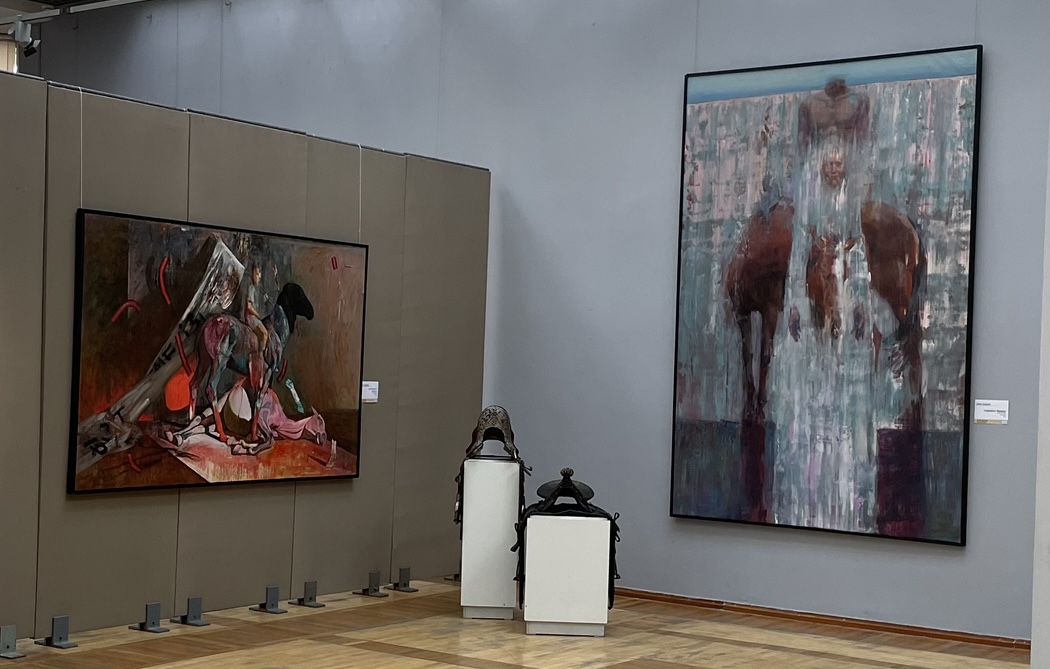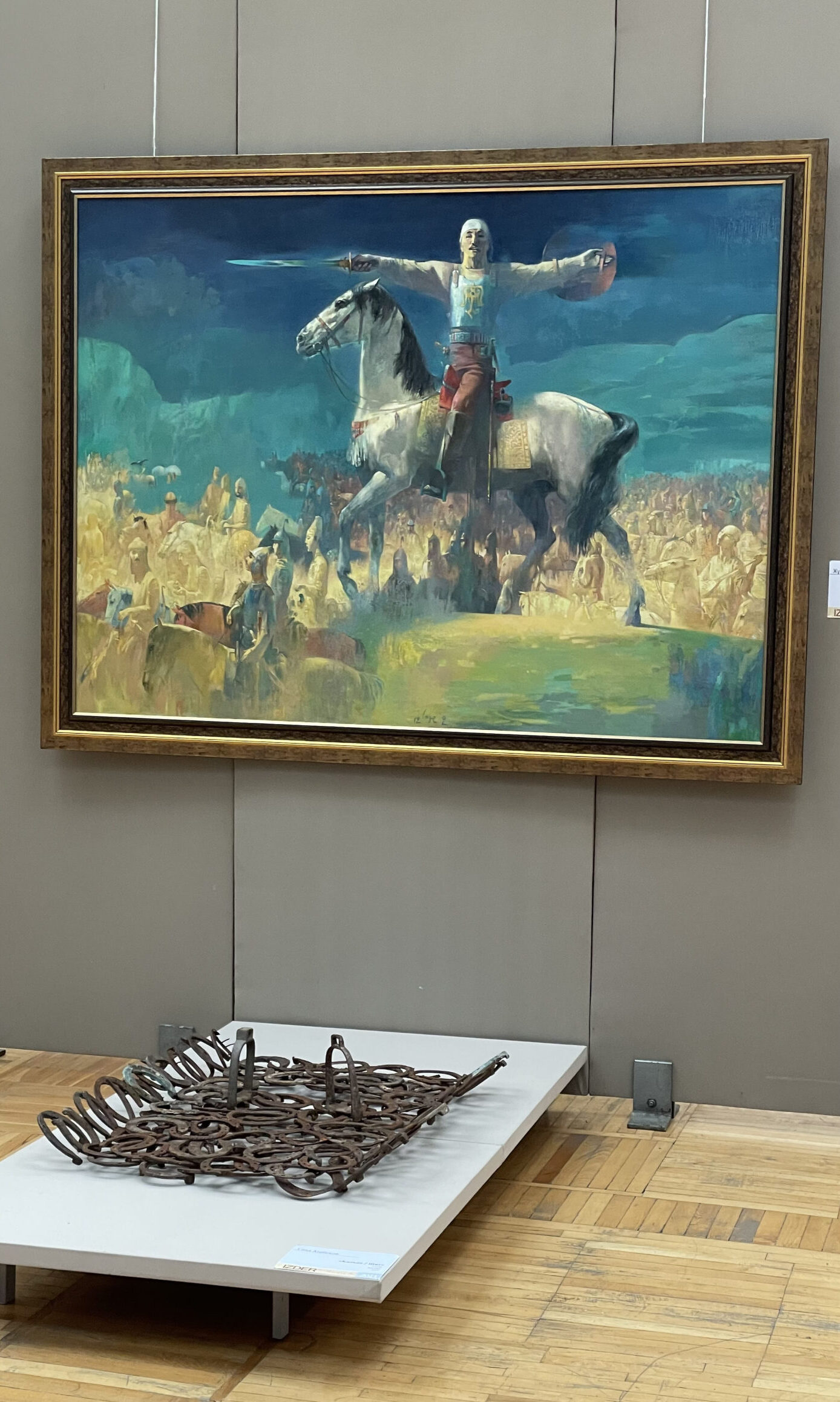The horse and the history of the Kazakh people are deeply intertwined. Our close relationship with horses began about 5,500 years ago. We believe our ancestors were the first people on the planet to climb on a horse’s back and ride it, then utilize it as a pack animal to carry our goods. We were also the first to begin using it as a source for milk and meat (and yes, the meat is delicious!).

This April Almaty-based Kasteyev State Museum of Arts is hosting the Angel’s Footprint exhibition, the fourth joint project featuring works of 21 artists. The main topic of the exhibition is the image of horse. Photo credit: The Astana Times.
Since those ancient times, the horse has become deeply entrenched in our Kazakh culture. It is not an exaggeration to say that for thousands of years, the horse WAS our culture. We were Turkic nomads who had no homes, buildings or towns — we lived in the saddle roaming free across vast steppes of Eurasia. We didn’t need and we didn’t want a lavish lifestyle full of precious metals and gemstones fashioned into household goods or jewelry — instead, we used such items to decorate our saddles, harnesses, bridles and other horse tack.

Assel Nussupova.
Our devotion to horses in ancient times is reflected in our historic sites. For example, at the Berel necropolis in the eastern part of Kazakhstan archeologists discovered an ancient mound. The individual entombed within was found laid on a block of wood along with seventeen horses. These buried horses were fully harnessed and saddled, wearing decorative straps made of pure gold.
While Kazakh culture, legend and archeology have pointed to a long and rich history with horses, modern science is now beginning to shed further light on the relationship between our corner of the world and the domestication of horses. A new study published recently in the journal Science Advances suggests that the Eurasian steppe was the home of the earliest known horse riders. Based on the evidence from remains found in burial mounds (kurgans), researchers from Finland have concluded that horseback riding originated in a remote area of the Western Eurasian steppe around 5,000 years ago.
Scientists have long been aware that horses were used by ancient cultures for milk and as a means of transporting goods. In particular, analysis of horses from the Botai culture (located in what is now Kazakhstan) suggests that the domestication of horses was widely established during the second half of the fourth millennium BCE. Other archaeological findings from the Mesopotamian period and the Old Babylonian period of the early second millennium BCE also provide some figurative evidence of horse domestication.

Horse serves as a source of inspiration for artists. Photo credit: The Astana Times.
While these findings certainly support the importance of horses in ancient culture, they were not, in the opinion of the study featured in Science Advances, sufficient to prove that horses were actually being ridden on the Eurasian Steppes 5000 years ago. That would take even more compelling proof. Bioanthropologist Martin Trautmann of the University of Helsinki had his team examine the bones of human skeletons from Eurasian burial mounds. They learned that the people buried in the ancient mounds didn’t just keep horses for milk, agriculture, and the transportation of goods — they, in fact, rode the horses and used them to herd cattle.
The scientists came to these conclusions on the basis of “changes in bone morphology and distinct pathologies associated with horseback riding.” They used six criteria that indicated an individual’s bones had been impacted by horse riding. These included signs such as stress patterns on the muscle attachment sites on the pelvis and femur; alterations in the shape of the hip sockets; marks caused by the pressure of the hip socket on the head of the femur; the shape and diameter of the shaft of the femur; wear on the vertebrae caused by repeated shock compression; and any trauma associated with falling from, or being kicked or bitten by a horse.
Most of the skeletons that were studied belonged to the Yamnaya people, who, according to CNN, “originated on the Pontic-Caspian steppe that stretches from southeastern Europe into Kazakhstan, skirting north of the Black Sea and Caspian Sea along the way.” Written in their bones is evidence of a way of life that we modern Kazakh’s still value as a touchstone of our cultural heritage – a life spent interacting with horses. It is fascinating to see how modern scientific study is confirming the story of human-horse connection that has long been told by the people of Kazakhstan.
For modern Kazakhstan, our nomadic way of life has now come to an end. We are no longer the fearless equestrian warriors we were long ago. We have stopped moving across the steppes on horses in search of animals to hunt and vegetation to harvest. Now we drive cars, live in skyscrapers, eat exotic foods and follow an instagrammable lifestyle unimaginable to our ancestors.
But our frame of mind is still much the same as that of our nomadic forefathers and foremothers, including those recently unearthed from the burial mounds – like them, we are open, curious, and always willing to explore new people, places, and concepts. We also continue to keep traditions and follow rituals that are inextricably linked to the horse. We lovingly call our children “my foal.” When a child takes his/her first steps, we gently tie a rope made of the horse’s hair around the baby’s feet, and let the most esteemed elderly family members cut it and give a blessing to the child.
As part of another Kazakh tradition, we give a foal or horse as a present on important occasions such as a wedding or the birth of a child. Our funeral and mourning traditions also include rituals connected to the horse. In addition to these rituals, we customarily prepare traditional food made out of horse meat for the hundreds of mourners who visit when a family member passes.
Regarding our food – yes, horse meat is a staple of the Kazakh diet. If you ever come to Kazakhstan, you will likely be served a traditional dish called Beshbarmak – boiled horse meat served on a bed of handmade pasta. You may also be offered kazy, horse sausage. These dishes are usually served at celebrations and various occasions to honor guests. Do not worry, though, the horses we eat are raised for meat, much like a herd of cattle in the West. We do not slaughter saddle horses – most often, we let a retired saddle horse live out his days as part of a wild herd.
We Kazakh love our horses. We give them human names. Even our own human names sometimes have references to horses in them. There is a Kazakh proverb that says, “We are humans with the horse’s personality.” The Kazakh people and the horse will forever be connected, linked by a proud history and a present that respects the customs of our past.
The author is an analyst with a Master’s Degree in Economics from Georgetown University in Washington, DC, with more than 20 years of experience working for the Kazakh government. She focuses on macroeconomics, commodity, financial markets, and economic and social policies in Kazakhstan and globally.

